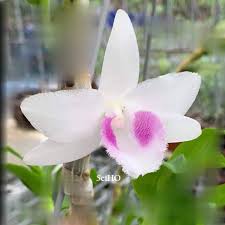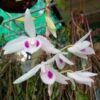# A Comprehensive Guide to Creating Ideal Conditions for Phalaenopsis Orchids to Bloom

Phalaenopsis orchids, commonly known as moth orchids, are among the most popular and beloved orchids due to their stunning beauty and relatively easy care. These orchids are native to tropical regions and thrive in conditions that mimic their natural habitat. To encourage blooming, it is essential to understand the specific environmental factors that affect their growth and flowering. This article provides a detailed guide on how to create the ideal conditions for Phalaenopsis orchids to bloom, covering aspects such as light, temperature, humidity, watering, fertilization, potting, and pest management.
## 1. Understanding Phalaenopsis Orchids
### 1.1 Botanical Characteristics
Phalaenopsis orchids belong to the family Orchidaceae and are known for their broad, flat leaves and long-lasting flowers. The blooms can last for several months and come in various colors, including white, pink, yellow, and purple. They typically bloom once or twice a year, depending on the care they receive.
### 1.2 Natural Habitat
In their natural environment, Phalaenopsis orchids grow as epiphytes, meaning they thrive on other plants without harming them. They are usually found in humid, tropical forests where they receive filtered sunlight and are exposed to warm temperatures. Understanding these conditions helps in replicating the ideal environment for indoor growth.
## 2. Creating Ideal Light Conditions
### 2.1 Light Requirements
Phalaenopsis orchids require bright, indirect light to thrive. Too much direct sunlight can scorch their leaves, while insufficient light can prevent blooming.
### 2.2 Optimal Light Placement
– **East or West Windows**: Place your orchid near an east or west-facing window. This allows for gentle morning or late afternoon sunlight, which is ideal.
– **Grow Lights**: If natural light is insufficient, consider using grow lights. LED or fluorescent grow lights can provide the necessary light spectrum for healthy growth.
### 2.3 Monitoring Light Levels
– **Leaf Color**: Healthy leaves should be a deep green color. If they become dark green, your orchid may not be receiving enough light. Conversely, yellowing leaves indicate too much direct sunlight.
– **Flowering Signals**: Phalaenopsis orchids need about 12-14 hours of light per day to stimulate blooming. Monitor the duration of light exposure throughout the year and adjust accordingly.
## 3. Managing Temperature
### 3.1 Temperature Requirements
Phalaenopsis orchids prefer warm temperatures. The ideal temperature range is:
– **Daytime**: 75°F to 85°F (24°C to 29°C)
– **Nighttime**: 60°F to 70°F (16°C to 21°C)
### 3.2 Temperature Variations
– **Day-Night Variation**: A slight temperature drop at night (about 10°F or 5°C) can encourage flowering by simulating their natural habitat conditions.
– **Avoid Sudden Changes**: Rapid temperature fluctuations can stress the plant, affecting its ability to bloom.
### 3.3 Seasonal Adjustments
In winter, ensure that the orchids are not exposed to cold drafts or temperatures below 60°F (16°C). In contrast, during summer, be cautious of overheating, especially in direct sunlight.
## 4. Maintaining Humidity Levels
### 4.1 Humidity Requirements
Phalaenopsis orchids thrive in high humidity levels, ideally between 50% and 70%.
### 4.2 Methods to Increase Humidity
– **Humidity Tray**: Place a shallow tray filled with water and pebbles under the orchid pot. As the water evaporates, it increases the humidity around the plant.
– **Misting**: Lightly mist the leaves with water in the morning. However, avoid excessive misting, which can lead to fungal issues.
– **Humidifier**: If your home is particularly dry, consider using a humidifier to maintain consistent humidity levels.
### 4.3 Monitoring Humidity
Use a hygrometer to monitor the humidity levels in the environment. Adjust your methods as needed to maintain the desired humidity range.
## 5. Watering Practices
### 5.1 Watering Frequency
Phalaenopsis orchids prefer to dry out slightly between waterings. Typically, watering once a week is sufficient, but this can vary based on environmental conditions.
### 5.2 Watering Method
– **Soak and Drain**: Water the orchid thoroughly, allowing excess water to drain out of the pot. Avoid letting the plant sit in standing water, as this can lead to root rot.
– **Check the Medium**: Before watering, check the moisture level of the potting medium. If it feels dry about an inch below the surface, it’s time to water.
### 5.3 Seasonal Adjustments
In cooler months, the orchid may require less frequent watering. Monitor the medium closely, as it retains moisture longer in lower light conditions.
## 6. Fertilization Techniques
### 6.1 Fertilizer Selection
Use a balanced, water-soluble orchid fertilizer (30-10-10 or similar) that contains essential nutrients like nitrogen, phosphorus, and potassium.
### 6.2 Fertilization Schedule
– **During Growth Phase**: Fertilize every 2 weeks during the growing season (spring and summer).
– **During Dormancy**: Reduce fertilization to once a month in the fall and winter when the plant’s growth slows.
### 6.3 Fertilizer Application
– **Dilution**: Always dilute the fertilizer to half-strength to avoid burning the roots.
– **Watering Before Fertilizing**: Water the orchid before applying fertilizer to prevent root damage.
## 7. Potting and Repotting
### 7.1 Potting Medium
Choose a well-draining potting medium designed for orchids, such as a mixture of bark, sphagnum moss, and perlite. This allows for adequate aeration and prevents root rot.
### 7.2 Pot Selection
Use a pot with drainage holes to facilitate excess water drainage. Transparent pots can be beneficial as they allow you to monitor root health and moisture levels.
### 7.3 Repotting Guidelines
– **Frequency**: Repot every 1-2 years, or when the potting medium breaks down and retains too much moisture.
– **Timing**: The best time to repot is after the orchid has finished blooming, as this minimizes stress on the plant.
## 8. Encouraging Blooming
### 8.1 Flower Spike Development
Phalaenopsis orchids typically produce flower spikes after resting for a period.
– **Rest Period**: Allow the plant to rest after blooming by reducing water and fertilization. This encourages the plant to store energy for the next blooming cycle.
### 8.2 Triggering Flowering
– **Temperature Drop**: A controlled temperature drop of about 10°F (5°C) at night for several weeks can help trigger blooming.
– **Light Adjustment**: Ensure the orchid receives adequate light, as previously mentioned, to stimulate flower spike development.
### 8.3 Patience
Blooming can take time, and some orchids may require several months to produce flower spikes after initiating the right conditions. Be patient and continue to provide consistent care.
## 9. Pest and Disease Management
### 9.1 Common Pests
Phalaenopsis orchids can be susceptible to pests such as:
– **Mealybugs**: Small, white, cotton-like pests that feed on plant sap.
– **Spider Mites**: Tiny pests that can cause leaf damage and webbing.
– **Scale Insects**: Small, hard-bodied pests that can appear on stems and leaves.
### 9.2 Pest Control Methods
– **Manual Removal**: Wipe pests off the leaves with a damp cloth or cotton swab dipped in rubbing alcohol.
– **Insecticidal Soap**: Use insecticidal soap or neem oil as a preventive measure or to treat infestations. Always follow the product instructions.
### 9.3 Disease Prevention
– **Good Air Circulation**: Ensure proper air circulation around the plant to prevent fungal diseases.
– **Avoid Overwatering**: Monitor watering practices to prevent root rot and other moisture-related issues.
## 10. Additional Tips for Success
### 10.1 Observation and Care
Regularly observe your Phalaenopsis orchid for signs of stress, pests, or disease. Prompt action can prevent further issues.
### 10.2 Seasonal Adjustments
Adapt your care routine based on seasonal changes. This includes adjusting watering, light exposure, and temperature as needed.
### 10.3 Research and Community
Engage with local orchid societies or online communities for advice and support. Many experienced growers can provide valuable insights and tips for successful orchid care.
## Conclusion
Creating ideal conditions for Phalaenopsis orchids to bloom requires attention to detail and an understanding of their unique needs. By providing the right balance of light, temperature, humidity, watering, and fertilization, you can encourage your orchids to produce beautiful blooms. Additionally, maintaining good health through pest and disease management will ensure your orchids thrive for years to come. With patience and dedication, you can enjoy the stunning beauty of Phalaenopsis orchids in your home, rewarding you with their enchanting flowers.

